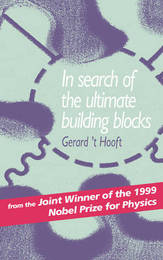
|
In Search of the Ultimate Building Blocks
Hardback
Main Details
| Title |
In Search of the Ultimate Building Blocks
|
| Authors and Contributors |
By (author) Gerard 't Hooft
|
| Physical Properties |
| Format:Hardback | | Pages:206 | | Dimensions(mm): Height 236,Width 160 |
|
| Category/Genre | Atomic and molecular physics |
|---|
| ISBN/Barcode |
9780521550833
|
| Classifications | Dewey:539.7 |
|---|
| Audience | |
|---|
| Illustrations |
7 Tables, unspecified; 22 Line drawings, unspecified; 7 Tables, unspecified; 22 Line drawings, unspecified
|
|
Publishing Details |
| Publisher |
Cambridge University Press
|
| Imprint |
Cambridge University Press
|
| Publication Date |
28 November 1996 |
| Publication Country |
United Kingdom
|
Description
This is a first-hand account of one of the most creative and exciting periods of discovery in the history of physics. From 1960 until 1990 theoreticians and experimentalists worked together to probe deeper and deeper into the basic structure of reality, moving closer and closer to an understanding of the ultimate building blocks from which everything in the Universe is made. Gerard 't Hooft was closely involved in many of the advances in the development of the subject. In this book he gives a personal account of the process by which physicists came to understand the structure of matter, and to speculate on possible directions in which the subject may evolve in the future. This fascinating personal account of the last thirty years in one of the most dramatic areas in twentieth century physics will be of interest to professional physicists and physics students, as well as the educated general reader with an interest in one of the most exciting scientific detective stories ever.
Reviews'One of the most difficult hurdles to be overcome in explaining particle physics to the layperson is to find analogies by which difficult abstract concepts and advanced mathematics can be communicated simply and faithfully. It is just one of the hurdles over which Gerard 't Hooft leaps, apparently effortlessly, in this rattling good read ... an entertaining mix of high theory and solid experimental facts, laced with his individual brand of dry and ingenuous humour ... The style of this book is highly engaging and is simply and succinctly written.' John Ellis, Physics World 'As a comprehensive and compact review of the taxonomy of the particle world, it should come in handy for physicists of other disciplines who are a little rusty on their particle physics ... the book is liveliest as a story of the fate of the ideas generated by the atom-smashing community ... the story is told with a confidence that comes only from deep understanding.' Tania Monteiro, New Scientist 'Gerard 't Hooft is a distinguished theoretical physicist whose ideas and opinions should be of great interest to anyone curious about the development of physics in the late twentieth century. In this nonmathematical but demanding little book, he gives his personal perspective on the areas of physics with which he has been concerned - chiefly the theory of elementary particles and the quantum theory of gravity ... one finds on every page of this book sharp statements and novel formulations that show the workings of a first-rate, confident and original mind. It deserves attention.' Frank Wilczek, Nature '... packed with colourful analogies, lively anecdotes and personal reflections ... It isn't Hooft's personal reflections that make this book enjoyable ... for the general reader who has developed an interest in particle physics, physics students and even the professional physicist, it is definitely worth reading.' Valerie A. Noyes, Times Higher Education Supplement 'In Search of the Ultimate Building Blocks is a nice, readable and comprehensible book. It is a valuable contribution to the popular physics literature and I would recommend all physics students and all physicists in different fields to read 't Hooft's book.' M. Gurses, Classical Quantum Gravity '... a wonderful account of the development of the Standard Model ... I recommend it most enthusiastically.' Lewis Ryder, Astronomy Now
|